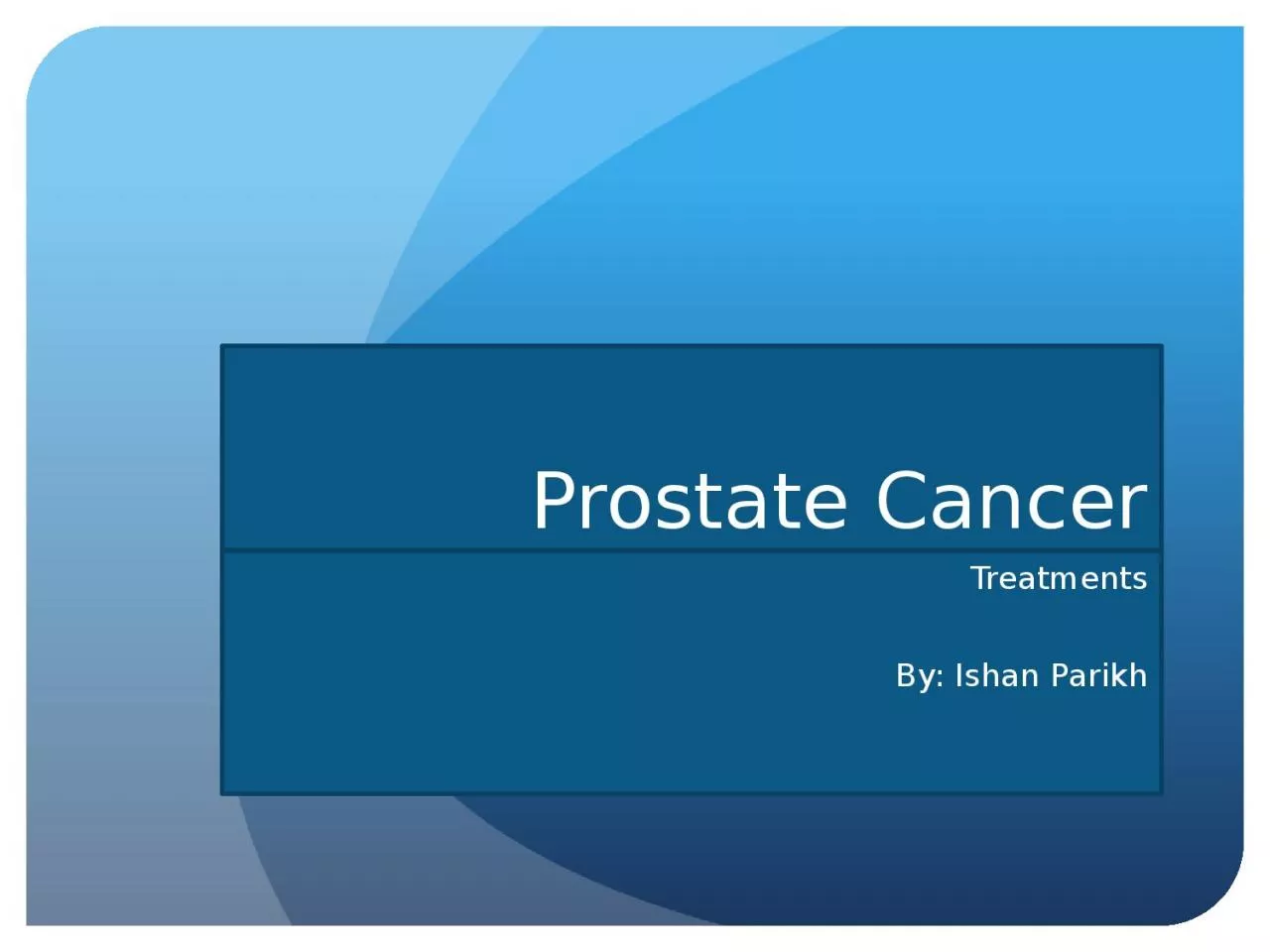

By Ishan Parikh Symptoms Be on the look out for stopandgo flow of urine Sudden urges to urinate Frequent urination esp at nights Trouble starting urination Trouble with emptying bladder completely ID: 1040475
Download Presentation The PPT/PDF document "Prostate Cancer Treatments" is the property of its rightful owner. Permission is granted to download and print the materials on this web site for personal, non-commercial use only, and to display it on your personal computer provided you do not modify the materials and that you retain all copyright notices contained in the materials. By downloading content from our website, you accept the terms of this agreement.
1. Prostate CancerTreatmentsBy: Ishan Parikh
2. SymptomsBe on the look out for…“stop-and-go” flow of urineSudden urges to urinateFrequent urination (esp. at nights)Trouble starting urinationTrouble with emptying bladder completelyPain or burning while urinatingBlood where it does not belongOngoing pain in the back, hips, or pelvisGeneral tiredness, fast heartbeat, dizziness, paleness
3. Why those symptoms?You may have some prostate issues..BPH (Benign Prostatic Hyperplasia) vs Prostate Cancer~1 in 5 US men, mainly older, will be diagnosed with prostate cancer
4. Tests for diagnosisDigital Rectal ExamPSA (Prostate-specific antigen) testTransrectal ultrasoundTransrectal biopsy
5. Factors for prognosisThe chance of recovery depends on…State of the cancer (PSA level, Gleason score, tumor grade, and stage of cancer)Patient’s ageWhether first diagnosis or recurrentThe treatment options depend on…Other health issues of patientExpected side effects of each treatmentPast treatments influence new treatmentsThe patients’ choice
6. Staging and GradingPreviously discussed how cancer is staged and graded… but what tests help in that process?Bone scan – checks if cancer cells are in the bone by sending radioactive material to collect abnormal cellsMRI – using magnets and radio waves, makes a series of detailed pictures inside bodyCT (CAT scan) – uses X-rays to make detailed pictures of body from different anglesPelvic lymphadenectomy – remove lymph nodes to view tissue under microscopeSeminal vesicle biopsy – views fluid under microscope to look for cancer cells
7. Treatment OverviewCurrent optionsStagesWatchful waiting, active surveillanceI, II, III, IVSurgeryI, II, III, IVRadiation therapyI, II, III, IVChemotherapy IVHormone therapyII, III, IVBiologic therapy – uses patient’s own immune systemIVBisphosphonate therapy – drug for bone metastasisIVTargeted therapy – drugs to target specific cellsIVNew Options (clinical trials)StagesCryosurgeryI, II, IIIHigh-intensity focused ultrasoundI, IIProton beam radiation therapyII, III
8. Treatment optionsWatchful waiting – Closely monitoring patient condition without giving treatment until symptoms show-Test results positive, but no symptomsActive Surveillance – Closely following condition without treatment unless there are changes in test results-Symptoms and test results positive, but very low risk
9. SurgeriesRetropubic prostatectomy – incision made in abdominal wallPerineal prostatectomy – incision made between scrotum and anus
10. Surgeries (con’t)Transurethral resection of the prostate (TURP) – helps in treating BPH by removing some tissue from prostate, but not allHolmium laser enucleationProblemsImpotenceLeakage of urine(Incontinence)Shortening penisInguinal hernia
11. RadiationExternal – makes a 3-D picture of tumor and beams are shaped to fit the tumorInternal (Brachytherapy) – radioactive substance is placed near cancer. (strontium-89)Use ultrasound + CT to accurately place seedsProblemsImpotence and urinary problemsIncreased risk of bladder or rectal cancer
12. Hormone therapyMany hormonal changes can help reduce size of prostateMain goal is to stop making testosteroneProblemsHot flashesImpaired sexual function and loss of desireWeakened bonesOther common side effects – diarrhea, nausea, itching
13. ChemotherapyWidely used cancer treatment, but mostly for metastasized cancersKills all newly growing cells in body-including bone marrow, lining of mouth and intestines, and hair folliclesProblemsMany side effects – nausea, vomiting, diarrhea, lowered resistance to infection, easily bruised, fatigueLowers white and red blood cellsMost side-effects are short term
14. Bisphosphonate + Targeted + Biological therapiesThese are not fix-all cures, they are helpersBisphosphonate - drugs help to reduce bone disease and pain when cancer spread to bones. Inhibit bone cell type that causes bone break downTreats osteoporesisTargeted therapy –drugs that find and attack certain cells without harming othersHormone therapy is an exampleBiologic therapy – uses own immune system to make more cells in a laboratory
15. Targeted TherapySignal A > Hormone XHormone Y > Hormone XIf altering hormone Y does not work, then targeted therapies will alter signal A
16. Clinical trialsCryosurgery – freezes and destroys cancer cells by using special instrument. Ultrasound is used to find area to be treatedHigh-intensity focused ultrasound – uses very high energy sound waves to try and destroy cancer cells. The cancer cells heat up and become destroyedProton beam radiation – uses high energy external radiation in streams of protons. Currently being studied
17. For more information….Visit https://www.cancer.govhttp://www.youtube.com/watch?v=Xus8nrth7eM